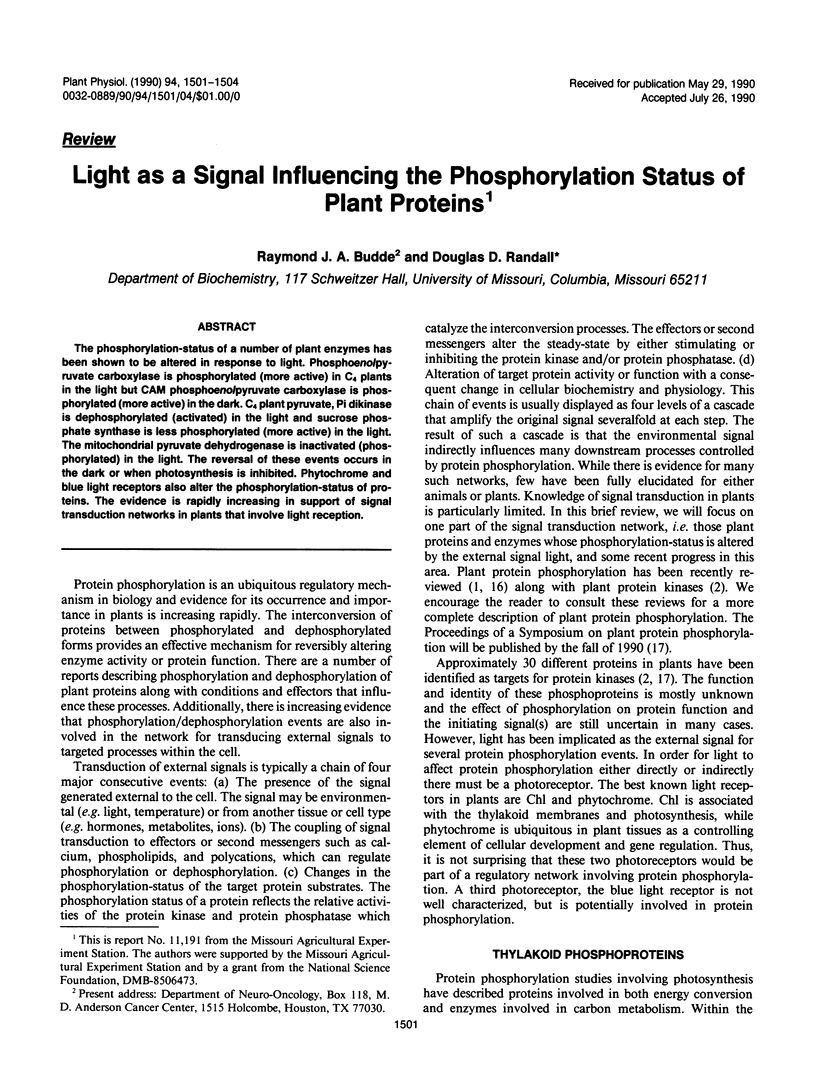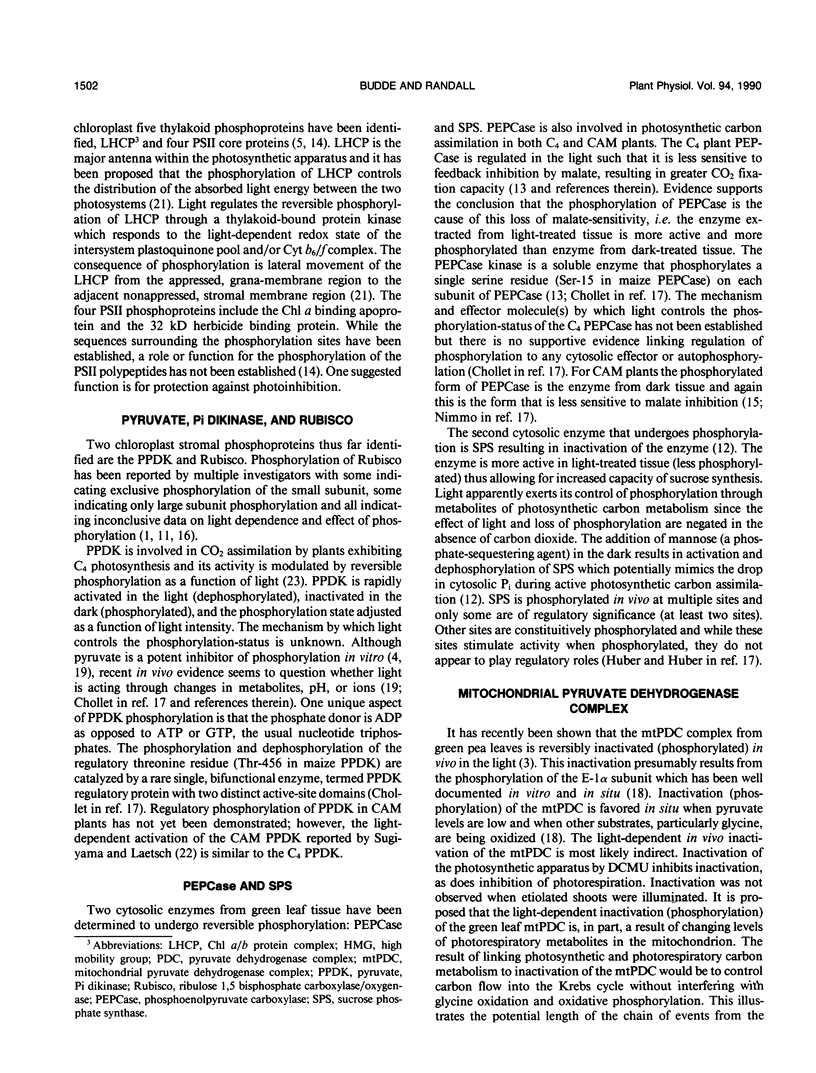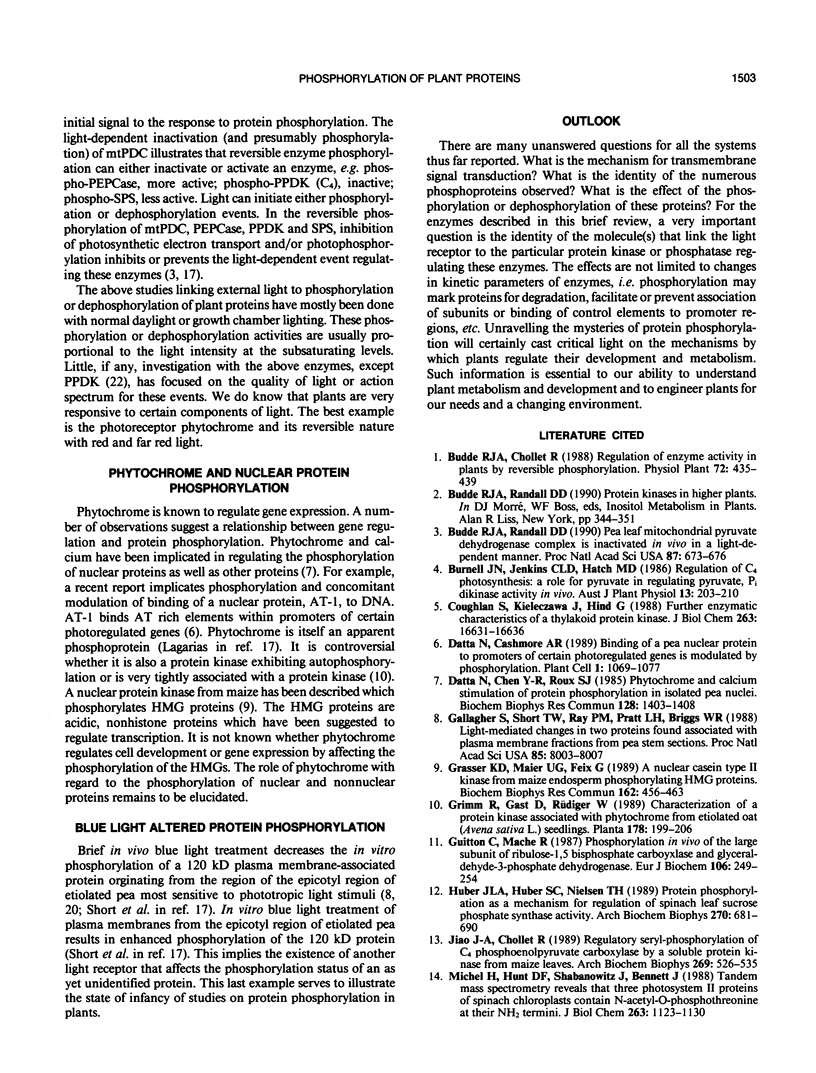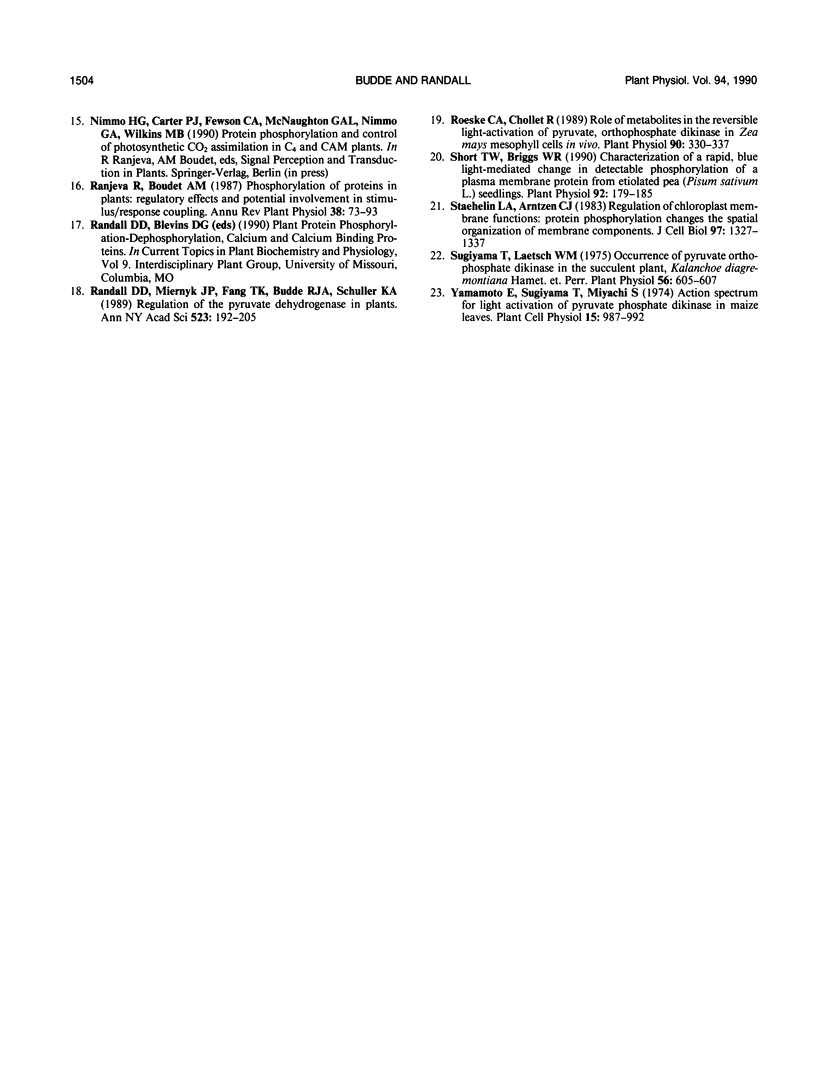Abstract
The phosphorylation-status of a number of plant enzymes has been shown to be altered in response to light. Phosphoenolpyruvate carboxylase is phosphorylated (more active) in C4 plants in the light but CAM phosphoenolpyruvate carboxylase is phosphorylated (more active) in the dark. C4 plant pyruvate, Pi dikinase is dephosphorylated (activated) in the light and sucrose phosphate synthase is less phosphorylated (more active) in the light. The mitochondrial pyruvate dehydrogenase is inactivated (phosphorylated) in the light. The reversal of these events occurs in the dark or when photosynthesis is inhibited. Phytochrome and blue light receptors also alter the phosphorylation-status of proteins. The evidence is rapidly increasing in support of signal transduction networks in plants that involve light reception.
Full text
PDF



Selected References
These references are in PubMed. This may not be the complete list of references from this article.
- Budde R. J., Randall D. D. Pea leaf mitochondrial pyruvate dehydrogenase complex is inactivated in vivo in a light-dependent manner. Proc Natl Acad Sci U S A. 1990 Jan;87(2):673–676. doi: 10.1073/pnas.87.2.673. [DOI] [PMC free article] [PubMed] [Google Scholar]
- Coughlan S., Kieleczawa J., Hind G. Further enzymatic characteristics of a thylakoid protein kinase. J Biol Chem. 1988 Nov 15;263(32):16631–16636. [PubMed] [Google Scholar]
- Datta N., Cashmore A. R. Binding of a pea nuclear protein to promoters of certain photoregulated genes is modulated by phosphorylation. Plant Cell. 1989 Nov;1(11):1069–1077. doi: 10.1105/tpc.1.11.1069. [DOI] [PMC free article] [PubMed] [Google Scholar]
- Datta N., Chen Y. R., Roux S. J. Phytochrome and calcium stimulation of protein phosphorylation in isolated pea nuclei. Biochem Biophys Res Commun. 1985 May 16;128(3):1403–1408. doi: 10.1016/0006-291x(85)91096-4. [DOI] [PubMed] [Google Scholar]
- Gallagher S., Short T. W., Ray P. M., Pratt L. H., Briggs W. R. Light-mediated changes in two proteins found associated with plasma membrane fractions from pea stem sections. Proc Natl Acad Sci U S A. 1988 Nov;85(21):8003–8007. doi: 10.1073/pnas.85.21.8003. [DOI] [PMC free article] [PubMed] [Google Scholar]
- Grasser K. D., Maier U. G., Feix G. A nuclear casein type II kinase from maize endosperm phosphorylating HMG proteins. Biochem Biophys Res Commun. 1989 Jul 14;162(1):456–463. doi: 10.1016/0006-291x(89)92019-6. [DOI] [PubMed] [Google Scholar]
- Guitton C., Mache R. Phosphorylation in vitro of the large subunit of the ribulose-1,5-bisphosphate carboxylase and of the glyceraldehyde-3-phosphate dehydrogenase. Eur J Biochem. 1987 Jul 1;166(1):249–254. doi: 10.1111/j.1432-1033.1987.tb13509.x. [DOI] [PubMed] [Google Scholar]
- Huber J. L., Huber S. C., Nielsen T. H. Protein phosphorylation as a mechanism for regulation of spinach leaf sucrose-phosphate synthase activity. Arch Biochem Biophys. 1989 May 1;270(2):681–690. doi: 10.1016/0003-9861(89)90551-1. [DOI] [PubMed] [Google Scholar]
- Jiao J. A., Chollet R. Regulatory seryl-phosphorylation of C4 phosphoenolpyruvate carboxylase by a soluble protein kinase from maize leaves. Arch Biochem Biophys. 1989 Mar;269(2):526–535. doi: 10.1016/0003-9861(89)90136-7. [DOI] [PubMed] [Google Scholar]
- Michel H., Hunt D. F., Shabanowitz J., Bennett J. Tandem mass spectrometry reveals that three photosystem II proteins of spinach chloroplasts contain N-acetyl-O-phosphothreonine at their NH2 termini. J Biol Chem. 1988 Jan 25;263(3):1123–1130. [PubMed] [Google Scholar]
- Randall D. D., Miernyk J. A., Fang T. K., Budde R. J., Schuller K. A. Regulation of the pyruvate dehydrogenase complexes in plants. Ann N Y Acad Sci. 1989;573:192–205. doi: 10.1111/j.1749-6632.1989.tb14997.x. [DOI] [PubMed] [Google Scholar]
- Roeske C. A., Chollet R. Role of Metabolites in the Reversible Light Activation of Pyruvate, Orthophosphate Dikinase in Zea mays Mesophyll Cells in Vivo. Plant Physiol. 1989 May;90(1):330–337. doi: 10.1104/pp.90.1.330. [DOI] [PMC free article] [PubMed] [Google Scholar]
- Short T. W., Briggs W. R. Characterization of a Rapid, Blue Light-Mediated Change in Detectable Phosphorylation of a Plasma Membrane Protein from Etiolated Pea (Pisum sativum L.) Seedlings. Plant Physiol. 1990 Jan;92(1):179–185. doi: 10.1104/pp.92.1.179. [DOI] [PMC free article] [PubMed] [Google Scholar]
- Staehelin L. A., Arntzen C. J. Regulation of chloroplast membrane function: protein phosphorylation changes the spatial organization of membrane components. J Cell Biol. 1983 Nov;97(5 Pt 1):1327–1337. doi: 10.1083/jcb.97.5.1327. [DOI] [PMC free article] [PubMed] [Google Scholar]
- Sugiyama T. Occurrence of Pyruvate Orthophosphate Dikinase in the Succulent Plant, Kalanchoë daigremontiana Hamet. et. Perr. Plant Physiol. 1975 Nov;56(5):605–607. doi: 10.1104/pp.56.5.605. [DOI] [PMC free article] [PubMed] [Google Scholar]


